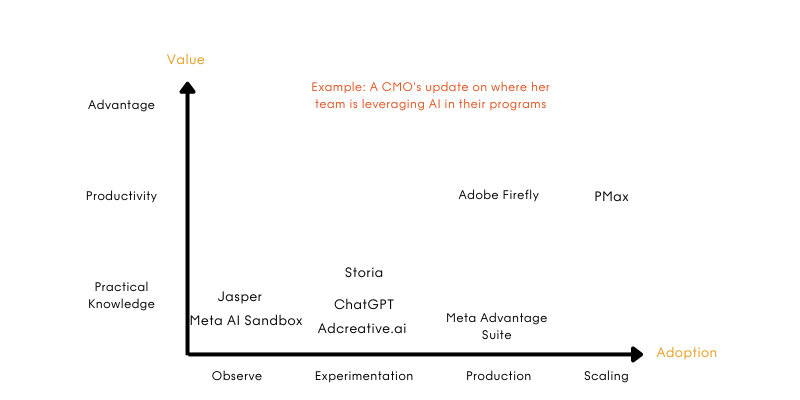(Note: This post is intended for leaders of marketing teams. In a future post, we’ll share an agenda and plan for an offsite where the senior leadership team and trusted staffers can align on a unified approach. )
The questions come in the late hours when company leaders worry: “What are we doing about AI? How are we using ChatGPT?” Or in hushed, urgent conversations while walking down the hallways in between meetings: “Hey, I’ve got a board meeting. What should I say about AI?”
Just about every marketing director, VP, and CMO is feeling pressure to have plans for using AI. They’re getting nervous texts and emails seeking an opinion and a response for the step-change in opportunities and threats that AI tools are bringing to the org. The board wants strategies and projections, the working teams want permission, and the other stakeholders want to “align” and “partner.” No one wants to be left behind or seem like they aren’t on the edge, and AI is the urgent topic for all business leaders.
However, all the marketing folks that are actually “hands on” with the tools realize the truth:
- Wonder – There’s a real sense of awe at what the tools and tech can do. It’s not a trick, it’s not just a novelty. The tools are incredibly powerful. A genuinely new era is in front of us, but we don’t fully understand what it might mean.
- Too early to make big bets – Its still so early. The transformations will come, but we can’t fully see it right now. For instance, ChatGPT, while seeming like a finished product, is still a primitive. Who can imagine what we’ll have in three years?
- Shiny vs Real – It’s hard to tell right now, what tools and tech are actually real (i.e. production ready, useful, trustable) and what are demonstrations. Worse, what applications of AI are just spin, basic algorithms being presented as AI.
- Risk – There are obvious risks in doing too much too early, despite the interest and energy to embrace the excitement. No one wants to undermine critical results by using early tech. Maybe this isn’t the time to be first; maybe this is the time to be a fast follower?
Marketing leaders are being asked to lead at a time when the “fog” of Martech is thicker than ever. But, that ambiguity doesn’t relieve any pressure for progress.
What’s needed is a way to both be on the offensive and defensive at the same time. Leaders will need a way to communicate they’ve got a plan – a point of view, priorities, and a way to sequence work – but also a way to guard against distractions, shiny objects and time wasters.
What’s needed is a map that shows what your team is working on now, and what might come next for the org.
A Simple Framework to Guide Planning and Discussions
In a highly dynamic environment where new tooling options and new methods emerge fast, leaders have to guide the adoption in a thoughtful, managed way. As the marketing leader, you want to demonstrate your team sees the opportunity in AI but is also integrating new tools and deliberately. At the same time, you want to help your teams understand how to move forward.
Despite the urgency, you can’t do everything all at once. Part of your job is to set the vision for how value will get created via the adoption of AI.
We see the need for a framework that maps a team’s AI initiatives against business value created and stages of team adoption. With a tool like this, leaders can have meaningful conversations around choices, resourcing, results, and team development. Here’s our first version, and we anticipate we’ll go through multiple versions over time.

To grossly simplify for the purposes of an example, your framework should represent a vision that is driving towards the following:
- Strategic Advantage – Can these tools help your team develop some sort of sustained edge in your marketing work that gives your company an advantage of some type? It could be the way creative is built, consumer insights are developed. It might be new processes are dramatically changed ways of working. For an example from another era, Redbull has built its marketing advantage via content creation capabilities, unique relationships with creators and athletes, “Owned” media, and market insights. In an even earlier era, Proctor and Gamble had a talent advantage due to their approach to hire, develop, and advance talented leaders. AI will enable those sorts of game-changing advantages, but you have to make it the ultimate objective.
- Scaled Expansion – The capabilities and tools your marketing team develops should be able to work at scale. That is, it should be 100% dependable, with all the spend behind it, with minimal risk for the team, the consumer, the brand, and the company.
Therefore, over time, your efforts in AI should be prioritized through the filter of what can scale up, and drive real strategic advantage.
As you think about the pipeline of AI related work your team could take on, you can place that work on the grid to show both the maturity of the work and your sense of the value it’s delivering.
Y Axis: How AI is creating Value for the Org
The Y axis shows the way value is created. In this model, we’re looking at company value, not just functional impact. So, while there’s value in easing the workload of an individual on a team with AI tools, the real benefit should be flowing to the organization overall.
- Advantage – The highest value. Your capability or tooling gives you a sustained, ongoing (maybe even long term) advantage that your competitors don’t have. The advantage makes it easier, more efficient, or more effective than what your competitors have to take on. For example: Perhaps some custom AI tooling enables your team to generate unique, actionable customer insights from your operational data.
- Productivity – Measurable improvements in efficiency (i.e., cost savings, time savings, skipped steps, etc.) or measurable improvement in effectiveness. There are other ways the AI tools will drive impact, but mainly you’ll want to show what efforts are delivering productivity for your team.
- Practical Knowledge – Before you can really drive impact, your team needs to understand the tools and how they work. That’s valuable in and of itself since it creates the conditions and knowledge that can unlock new ideas, smart application of the tech, and navigate the risks inherent in AI.
X Axis: Stages of AI Adoption, from Observing to Scaling
The X axis shows how your team is going from ideas to scaled deployment in, hopefully, a structured, methodical way.
- Monitoring and Observing – In this stage, your team is in “understand it” mode. You’re listening to vendors, you’re reading papers, checking out websites, listening to podcasts, etc. This is where your team is getting smarter, building an understanding of what’s possible, how the tools might be applied. You might have some ambitious, curious people that are tinkering or dabbling in their spare time. The priority would be deciding where and when to start experimenting and which “problem” would get addressed via experimentation.
- Experiments – You’re moving into action mode here. Your team is actively working with the tools, on real work, in a meaningful way. There’s some structure via controlled experimentation and knowledge sharing. Focus is on “What are we learning? Is the output good? Can we trust it? Will this work at scale? How would we make this part of the job?” The team is doing more than dabbling. The goal in this stage is to understand whether a real impact can be made and whether the tools/tech can be dependable.
- In Production / BAU – This is where your team is leveraging the tools on a day-to-day basis, where results and quality matter. The team should be able to see productivity gains or improved results. Confidence in the tool is growing.
- Scaled Expansion – The tools become core to the work and “standard” for the team. Usage should grow because the team is seeing increased value, such as process efficiency, improved ROI, better work, etc.
Your Roadmap: Bringing it all together
As the marketing leader, you and your team should be regularly, openly discussing what to add into your mix through basic experimentation and pilots on production work. Over time, you’ll have a busy grid that communicates where experimentation is happening but also where scaled impact is driving productivity for the company.
Here’s an example grid for a hypothetical marketing team that is:
- Experimenting with Storia to use AI to storyboard social videos; ChatGPT for posts, and Adcreative.ai for posts and creative units
- Putting Adobe Firefly into production
- Scaling up Google Performance Max since the team is seeing consistently better conversion rates
- Monitoring Jasper (for copywriting) and Meta AI Sandbox to learn how generative ads might work in their model

With a roadmap like this, the leader can easily add tools and tech to the “Observe” column when a senior leader or staff member suggests it. At the same time, the leader can communicate the care and methods being used to weave AI into the overall operating model for the team.
Every team will have a different set of initiatives on their grid. Business conditions, partner choices, budgets, and talent development considerations will mean a unique grid of work. More importantly, this grid can be updated and communicated each quarter to ensure company leadership, key agency partners, the team, and other stakeholders are in the loop with new and interesting integration of AI.
Its Time to Act
A lot of marketers have watched the explosion of AI tools over the last year. While the main focus is on the breakthrough tools (the generative tools, the LLMs), more and more vendors are incorporating the AI into their functionality. It’s time for marketing teams to get moving. Having a framework to guide decisions and experiments will help remove some of the fear and uncertainty and will give teams a way to steadily integrate AI in a strategic way.



